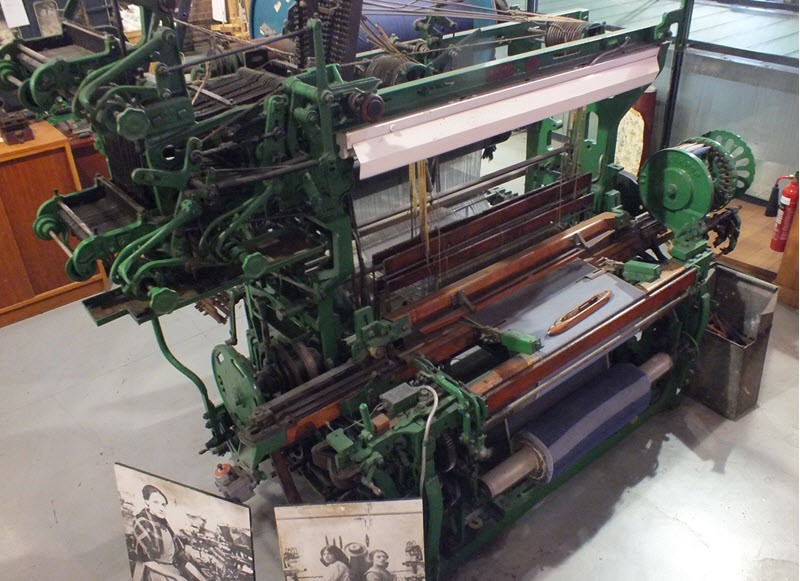The Northrop Loom was a fully-atomatic power loom introduced in 1894-1895. It is named after James Henry Northrop who invented its shuttle-charging mechanism. The Northrop Loom was marketed by George Draper and Sons, a company based in Hopedale, Massachusetts.
With the Northrop loom, the textile industry could achieve higher levels of production, and the loom became very sought after in the business. By 1900, over 60,000 Northrop looms had been sold, the Draper company was employing 2,500 people to keep up with demands, and circa 1,500 new looms were shipped each month.
James H. Northrop was a prolific inventor in the field of weaving and had over a hundred patents to his credit. By the age of 42, his financial situation allowed him to buy a fruit farm in Santa Ana, California and retire. On his farm, he focused on growing dates as a gentleman farmer and spending his days fishing. When he died at the age of 84, he was survived by his widow Emily Driver (who came from his hometown in Yorkshire), their five daughters, two grandchildren, and three great-grandchildren.

Inventing the shuttle-charging mechanism
Background
James Henry Northrop (1856-1940) was born in Keighley, West Yorkshire, England. He worked in the British textile industry, before migrating to the United States where he settled in Boston, Massachusetts in 1881.
In Boston, Northrop was employed by George Draper and Sons as a mechanic and foreman, and during this period of his life he invented a spooler guide.
Eventually, Northrop left the textile business and tried his hand at being a chicken farmer, but without success. It was around this time that he invented a shuttle-charger, and a model of it was show to Otis Draper (of the Draper company) in March 1889. It piqued his interest, and he provided Northrop with a loom to test the concept.
At the time, the Draper company was also working with the development of the Rhoades shuttle-charger, so there was some competition.
Inventing and perfecting
By May, 1889, Northrop had realized that his first model had practical failings, but he also came up with a new idea. On July 5, the completed loom was running and looked promising, even compared to the Rhoades loom.
In October, the Northrop shuttle-charge was given a mill trial at the Seaconnet Mills in Fall River, Massachusetts. It went well enough for more looms to be built and tested at Seaconnett later that year, and in 1890.
While the trials were in process, Northrop also invented a self-threading shuttle and shuttle spring jaws that would hold a bobbin using rings on the butt. This turned out to be a stepping-stone for his next invention: a filling-changing battery developed in 1891. This filling-changing battery would become the main feature of the Northrop loom.
Simultaneously, other members of the Draper company created a workable warp stop motion, and this was included in the Northrop loom.
Marketing of the Northrop loom commenced in 1894.
The design
The main advantage of the Northrop loom was that when a warp thread broke or the shuttle ran out of thread, the loom did not have to be stopped. Northrop´s mechanisms ejected the depleted pirn and loaded a new full one without stopping the loom.
Prior to the introduction of Northrop looms, it was standard for a one loom operative to be in charge of eight looms. With the automatic Northrop loom, one loom operative could instead handle 16 looms. Therefore, the weaving companies could save money on labour costs without reducing pay.
By 1914, roughly 40% of factory looms in the United States were Northrop looms.
Northrop looms in the United Kingdom
In 1902, Henry Philip Greg imported some of the first Northrop looms to the UK for use in his Albert Mill in Reddish, Lancashire. In 1909, his brother Robert Alexander Greg introduced Northrop looms at the Quarry Bank Mill.
In the United Kingdom, investing in a Northrop loom made less sense for the company owners, as labour salaries were significantly lower than in the United States. Therefore, the Northrop looms only had 2% of the British market by 1914.
Also, the Northrop looms got a reputation for being great for coarse cotton but less suitable for fine cotton, and this made many textile companies in Lancashire refrain from getting them as they used fine cotton.
